I am looking forward to this section.
Integral to my path is the method of enquiry I have attuned during the writing of Viveka-Zandtao. In this enquiry I have developed faith in the quest (satta) into the unknown, in this section the unknown is going to be what I will find when I examine “following the path”. Before continuing with this section I wrote this Zandtaomed Advice on  , I will be ZQuesting about path. , I will be ZQuesting about path.
Over my retirement years I have developed pathtivism, but in truth there is nowhere that I have given clear guidance on the path. In a sense the path is all things, it is all that matters, it is completely true as far as I know – I have some faith and some understanding that it is completely true. Connecting to the Dhamma is the path but to me that is a tautology, the advantage of saying this tautology is that for some people there is an understanding of what connecting to the Dhamma means, and therefore they can understand what the path is – what I mean by the path. But that requires a similar understanding of what connecting to the Dhamma means. In addition, there is the Indigenous path (posted here), path as connected to the Great Spirit similar to path connected to Dhamma:-
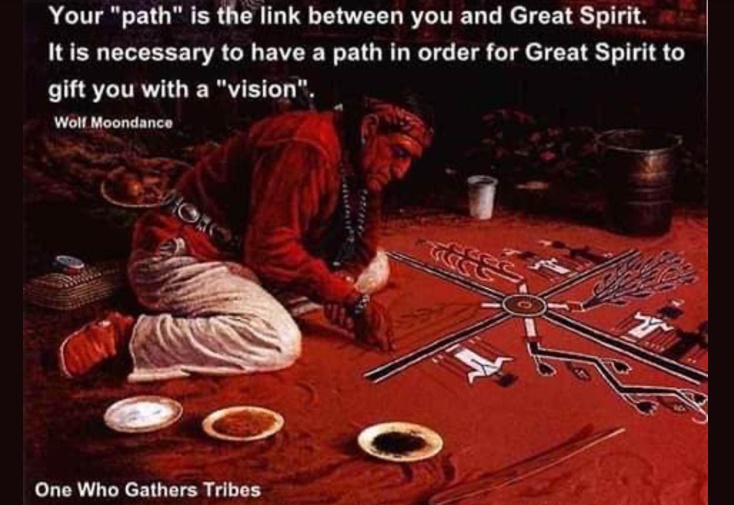
Whatever I end up developing in this section, the following has to be clear, there will be no definition of the path – defining is restricting, at best I suspect I can only offer what the path is not. But we will have to see.
This section will bring together my writing on pathtivism so far. Pathtivism means path activism. Pathtivism is 100% about following your path, the emphasis of activism in life is following the path – not the consequences of activism in daily life. Whatever form activism takes in life, whatever causes people lay claim to, whatever actions in struggle are taken, a pathtivist is conscious that it is as a consequence of following the path, and not that the activism of daily life is the purpose. Whatever activism your path chooses, however your path decides on how to work collectively, it is your path that you are following - the cause itself is part of your daily life and daily life is part of the world of conditioning. In this way pathtivism proposes a reframing of activism (as Caitlin did here). For most people activism is whatever activity a person chooses to make a change – even the appalling “make a difference”. On the path your pathtivism focusses on how to follow your path making pathtivism the core activism, the consequence of following the path will lead to some form of social activism because social activism is compassion; in some way there has to be 100% engagement even if there are no social actions pro tem. But if we cling to the social activism as meaning in life it is ego, when we follow our path and this leads to some form of social activism that is sampajanna – wise actions of compassion based on following the path. But pathtivism stresses this – follow the path first where your compassion takes you is a consequence.
Another word for following your path is autonomy. But again that only helps understanding if there is equivalent understanding, more than likely what is brought by these equivalent terms – following the path, connecting to the Dhamma, being autonomous – may cause some confusion but at least they will help with enquiry.
Key to understanding path and pathtivism is to understand the relationship between nature, path and pathtivism, I hope to develop that understanding in this section. Previously I have described a Buddhadasa understanding of Idappaccayata-Paticcasamuppada as nature or dhammajati. These are of course terms or concepts of which we will all have different interpretations, but some understanding of this might help – or it could cause confusion; again I hope to develop this in this section.
Let me cursorily examine previous pathtivist writings. In the Treatise I developed the 3 tenets and showed how they had affected my daily life:-
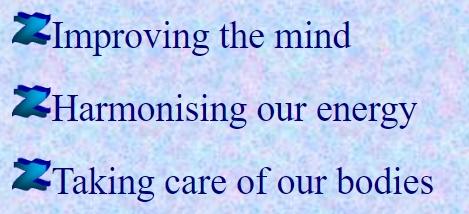
In writing the Treatise I wanted to show that the path had always been a part of my life, from upheaval onwards I followed my path however loosely – however much my reflective ego tells me I could have done better. Given the conditioning in life that works against following the path, the Treatise can show you firstgrace, insights and phala (eg bells and banjos) which are indicators-plus of your path. Please look for them in yourselves and act on them.
At the end of the Treatise I wrote this as the path:-

This is what I saw then as the path – I hope to develop it in this section, and this meme was the basis of the pathtivist manual. The manual began from a different standpoint to where I see it now. It started by trying to show how following the path would be beneficial to activism – in the first part looking at how following the path could help with the organising of the activism. But on the inner journey in the second part there began a completion process in which the 3 tenets became integrated into the path. As the clarity of this integration grew a recognition also grew that focussing on outer activism was not constructive. Following the path requires 100% engagement as pathtivism, with compassionate activism as consequence. This potential paradox is the reality of the path, our path in life, pathtivism, is about activism but it does not mean that we are always carrying placards, solitude with the purpose of following your path is activism – and pathtivism. Once the path had been integrated as described in the manual, it became clear that there was 100% complete disenchantment with activism in the world of conditioning without pathtivism. Activism of itself is not a reward, the rewards come from following your path in nature - pathtivism:-

Activism is your duty – not your reward, phala (fruits) from following your path are the reward. Pathtivism makes it clear that the path is what we do, what we follow as our duty, what provides our rewards. The duty that the path tells us to follow is not the reward, success in daily life is not the measure – daily life is the duty; the path is its own reward. And those rewards come in terms of fruits - phala.
It is important to note that path comes from nature, and if we all are in harmony with nature then there will be "peace on earth" - "earth in peace". In following our paths we are not making judgements as to right or wrong, we are not assessing the whole and defining our part, we are simply in harmony with nature. There is an understanding that nature will survive if we live in harmony with her, if we all follow the paths nature has given us. What we do is what we were born to do.
Through MwB and the Companion, I provided a way of developing your path. Unknown during my second childhood, and unknown at the time of writing, what I did in the Treatise and Manual is in some way equivalent to the 4 tetrads of the meditation of MwB and the Companion. Through the 3 tenets and integration into the path, I had followed the 4 tetrads of kaya (body), vedana (energy), citta (mind) and Dhamma (path integration) – the 4 foundations of mindfulness. By following Buddhadasa’s anapanasati-bhavana I was able to reinforce my approach to these 4 foundations to connect to the Dhamma – follow the path.
In Viveka-Zandtao I examined solitude, and came to recognise that my Viveka was how I followed the path. Throughout my daily life during the work of teaching that had been directed by my path of compassion, and during my activism whose purpose was enabling spirit even when stuck in a room licking envelopes, it was the times of solitude that helped me return to the path, that kept my life centred on the path. Once I found the path in upheaval, solitude maintained a hold on the path whilst fighting off the conditioning of daily life, and now I have the solitude that enables me to give back through Zandtao and Zandtaomed.
I have always seen writing as part of my path but in the writing of Viveka-Zandtao I have now recognised another path process – writing as enquiry  . Bouncing off the thoughts of an author takes me into an unknown – part of my quest, I have faith that this enquiry together with concomitant meditation to clear the mind will bring understanding. In the end I will review this writing as ego arising during the process might leave vestiges of error, clarity at the end of the quest and faith process reviews what has been written to try to ensure there is no delusion. . Bouncing off the thoughts of an author takes me into an unknown – part of my quest, I have faith that this enquiry together with concomitant meditation to clear the mind will bring understanding. In the end I will review this writing as ego arising during the process might leave vestiges of error, clarity at the end of the quest and faith process reviews what has been written to try to ensure there is no delusion.
Pathtivism is the name I have given to my understanding of the path. There is no separation of path and activism, 100% engagement, the purpose of following the path is to be wise in daily life - sampajanna. In Viveka-Zandtao I have examined solitude, quest and faith, all of which contribute to sampajanna - wise actions in daily life. Through  there is a method of deep enquiry; but this is not an academic exercise, the purpose of depth has intended consequences in the compassion of daily life. But the measure is not the rewards of success in daily life but the spiritual rewards of phala that come from dhammajati; the path has its own rewards, society's rewards might well be linked to defilement. there is a method of deep enquiry; but this is not an academic exercise, the purpose of depth has intended consequences in the compassion of daily life. But the measure is not the rewards of success in daily life but the spiritual rewards of phala that come from dhammajati; the path has its own rewards, society's rewards might well be linked to defilement.
For the pathtivist following the path is doing the best they can to be the best they can be. I will soon be looking at the Buddhist relationship to pathtivism. What I have found with Buddhism is that it discusses in detail areas of Dhamma and the mind, the very terminology such as anatta engages the mind in consideration of understanding not always discussed elsewhere. It is enquiring into the understanding that comes from the tradition and its use of this terminology which attracts me to Buddhism, with my mindfulness grappling with what has been written especially by Buddhadasa I have gained some understanding.
But doing the best I can to be the best I can be is the essential pathtivist understanding gained from life (and studies); it is vague yet concise.
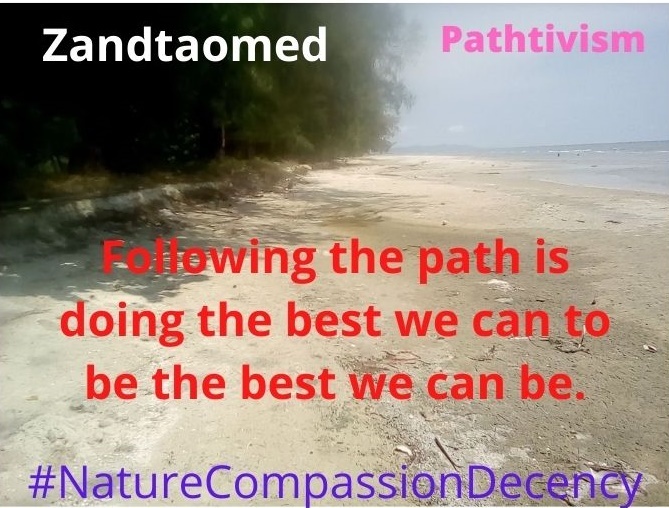
To begin looking at the path, I want to interpret how I see the Buddhist way of life. I am starting with this rather than describing a pathtivist way of life because Buddhism has been investigated by so many wise people. Basically Buddhism mostly stems from the teachings given by Gautama Buddha after he became enlightened. He taught that to live an enlightened life is to live, according to buddha-nature, a life of compassion to help end suffering for all; Buddhism could be seen as teachings to help do this. From this point on Buddhism gets confused because of proliferations, and I don’t have enough knowledge of these proliferations to describe them in a fair way. In terms of Buddhism I work with the teachings of Ajaan Buddhadasa.
Let me examine first of all “living a life of compassion to help end suffering”, this includes some of the description of the path given in the Treatise – compassion and ending suffering:-

Buddhism gives teachings that help us get to the state of mind where it is possible to live in this way. To get into this state of mind it is necessary to connect to Dhamma, and the purpose of dhamma teachings is to help you develop this connection. In MwB Buddhadasa provides an understanding of meditation (anapanasati) to help you connect to Dhamma. The problem here is that Dhamma is beyond description, Buddhadasa helps by teaching that MwB develops the 4 Dhamma comrades of mindfulness - sati, wisdom – panna, concentration – samatha, and wisdom-in-action – sampajanna. Whilst these are good indicators of the Dhamma they are not an actual description. At the same time this description opens up more questions asking what is mindfulness, wisdom, concentration and wisdom-in-action? We have gained some understanding but opened up a greater unknown.
To get to a better state of mind where we can improve our connection to Dhamma requires transcendence – in lokutarra we are closer to Dhamma. So how do we transcend? MwB. As part of MwB the 3rd tetrad on citta teaches us to understand supramundane states, one of which is compassion – karuna. Through meditation Buddhadasa teaches us how to develop better states of mind which hopefully in the end will connect; Lokutarra is one such state of mind where the connection is developed.
However let’s look at what the Dhamma is not. The Dhamma is not the teachings, the teachings help you connect to the Dhamma but it is not the state of mind itself; the path of pathtivism is not the teachings but something that is developed beyond the teachings.
But to begin to understand Buddhism we have to begin to understand dhammajati, the natural laws of Buddhism and the laws of conditionality, idappaccayata-paticcasamuppada:-
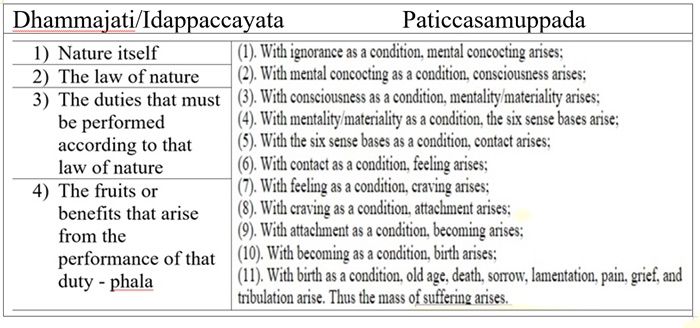
With an understanding of natural law, Buddhism recognises that from birth we are conditioned. Nature provides instincts for our survival, and these instincts develop egos and identity which initially help us survive. But as we mature as adults it is expected that we let go of these egos in order to live a life of compassion, it is expected that we go beyond our conditioning to do this; meditation such as MwB is one method for helping us let go of these egos. The Buddha’s teachings also teach us through the 4 Noble Truths how suffering arises, and how through ending attachment and craving we can end suffering by not attaching to desire, and elsewhere in the teachings, attaching to kilesa and clinging to upadana. [I should note here that the Noble 8-Fold path of the 4 Noble Truths is the Buddha’s recommended path to end suffering, but when I speak of path I am talking of something essential].
Here is how I described what the Buddha taught – “He taught that to live an enlightened life is to live, according to buddha-nature, a life of compassion to help end suffering for all”. So what is an enlightened life lived according to buddha-nature? And this question is beyond my ability to answer. I have faith that there is enlightenment as discussed in the last section, but beyond that I cannot describe it - partly because I suspect it is indescribable but mainly because I am not enlightened so how can I describe it. I also have faith that the path is buddha-nature, but beyond faith it is not possible for me to answer that either.
And we have reached a stage for consideration. There is a Buddhist way of life of compassion to end suffering through connecting to Dhamma. But the more we investigate the more we ask questions. But I have faith in the method; and, even if there are not definable answers, with questioning enquiry qualifies what is and what isn’t. Until we begin to ask it is not possible for mindfulness to grapple with the known and to quest into the unknown.
Above I noted “the Noble 8-Fold path of the 4 Noble Truths is the Buddha’s recommended path to end suffering but when I speak of path I am talking of something more essential”. Essence is a good word to get some indication. “Essence is a polysemic term, used in philosophy and theology as a designation for the property or set of properties that make an entity or substance what it fundamentally is, and which it has by necessity, and without which it loses its identity” Wiki. This is a useful definition to investigate:- “A property or set of properties that make an entity what it fundamentally is”. This could just be path, the properties of the path that make it fundamentally what it is. Does it add anything having this definition? It begins to when considered with what has been investigated so far. Could Dhamma be considered a set of properties – 4 Dhamma comrades plus? But when we think of the word “property” we are describing a fundamental – an axiom, something that cannot be analysed or broken down further. Properties are an essential description, but because they are axiomatic they only have meaning when the property is understood.
When we describe the properties of electricity, “Electricity is the flow of electrons through a conductor. The amount of current (amps) is related to the voltage (volts) pushing the electrons and the degree of resistance to flow (ohms). During their flow around a circuit, electrons can be used to create a number of useful by-products such as heat and light. As electrons flow, they alter the charge of the matter they flow through, which may also generate electromagnetic effects” ref, we can describe the effects but what meaning is the essence “a flow of electrons”? Path as Essence has a set of properties, eg 4 Dhamma comrades plus, that produce effects such as compassion, insight and creativity but there is no sense of definition here – and as said at the beginning of this section there cannot be.
But this does give us a useful approach to the path, can we develop an approach to life that produces these good effects – in Buddhist terms living a life of compassion that ends suffering for all? But it also leads to difficult questions – possibly unanswerable. Can we increase this Essence? How can we best use this Essence? There is a sense of going round in circles, we open a new way of describing – Essence, and we end up with the same – good effects but unanswerable questions. But that in itself is useful, however we look at the path there are unanswerable questions but good effects.
How do we connect the good effects to the Essence? For Buddhism there is a clear method including meditation, and for pathtivism I have added description to Buddhadasa’s MwB with the Companion. Because of the wisdom in the tradition there has been much investigation of getting the good effects from the Essence, but this approach is not exclusive to Buddhism. By whatever means we do get the good effects from the Essence, this is following the path – however we get the best effects that we can get. What is unanswerable is defining the Essence but there is the beginning, a measurement of “following the path” – the good effects. It is not so much the properties of the Essence or path that matters, but what are the good effects it produces? The Essence of seeking is finding the best way of producing good effects.
But we have to be careful here in how we measure good effects. In Buddhism the answer to this is clear – dhammajati measures by rewarding through phala. If there is no reward this can question the good effects; society’s reward can lead to defilement, the path’s reward is phala. Following the path is concerned with the rewards and how we recognise them. But whilst recognising phala is meaningful it is very much subjective. At firstgrace I talked of bells and banjos, during the jhana of writing there has been the presence of guys, there are good feelings during meditation, and generally just feelings of presence from being in harmony.
But these phala don't come at will, nor can they be verified - defining conditions and states of mind that will produce phala. The nearest I came to that was in the writing of Kirramura during which I had a routine for writing that involved being absorbed and waiting for phala prior to writing late at night. It worked at that time but is not part of any creativity now. We have to learn about our own phala, recognise them as they change, but note that phala cannot be created or formally developed. They are part of our path, are meant as rewards for following our path, but their only predictability is that they are unpredictable. Learn to recognise your phala so that you know when you are following your path.
That brings me to a question that I cannot answer, is there a meaning to absence of phala or absence of presence? Do we need to be rewarded for every right action? In the past there has been phala for certain good practices, do we need rewards for that or can we just use the Dhamma Comrades of panna and sampajanna - knowing what is wise and putting that into practice?
Social reward is not phala. How society measures "success" is not phala, how society measures spiritual success is not phala; these measures are personal and concerned with our own relationship to the path. But phala are real, personal and motivational; it is sad that it is not more widely known that following the path brings with it these phala. Phala is reward from the path, and the path should be known for having these rewards, but phala cannot be taught, predicted or developed by any scientific/verifiable method. MwB helps us follow our paths, and as we develop the Dhamma comrades through this approach there will be phala, but when and how cannot be defined; using MwB to develop phala is a misuse of the method, MwB is there to help us follow the path - phala are likely to happen but when and how cannot be controlled. I know nothing of siddhis but it is my understanding they are not phala, if you wish to connect siddhis to phala and your path you need to look elsewhere for instruction.
Essence as a set of properties, eg 4 Dhamma comrades plus, that produce effects such as compassion, insight and creativity led to an important understanding of the path, if we are following our path in some way there will be phala and recognising these phala empowers and motivates us. But there is an aspect of the quoted definition that is misleading:- "Essence is .... used .... as a designation for the property or set of properties that make an entity or substance what it fundamentally is .... and without which it loses its identity". In people the path or essence is not connected to their identity. Identity, as self and ego, grows through conditioning from instinct and the need to survive, and becomes a block to expression of essence in mature adults. Buddhadasa, in MwB, describes these characteristics arising from anapanasati:-
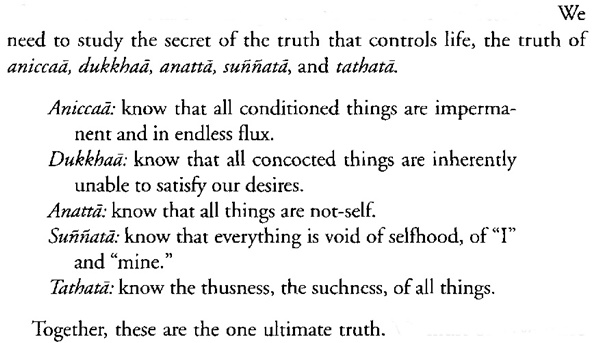
In describing what arises on the path, from our essence, we could describe 4 Dhamma comrades plus recognition of these characteristics as well as in some form, phala. Identity is not part of this. Earlier I wrote this concerning properties. Properties are an essential description but because they are axiomatic they only have meaning when the property is understood. With regards to "4 Dhamma comrades plus", understanding the meaning of the 4 Dhamma comrades plus these 5 characteristics (of one ultimate truth) and recognising phala brings some understanding of the path.
And this esoteric journey relates to phala. Phala do not necessarily come to those who study the dhamma or other teachings, they come like Archimedes' Eureka when the teachings have developed insight. Insight is part of the esoteric journey, and it is the esoteric journey that is rewarded. Phala rewards the esoteric journey, the Essence of the path. Essence reconnects to sunnata so as such cannot be described, but we can know there has been such a connection because of phala. Good effects will follow from this connection and can be observed, but phala are the individual spiritual motivations for following the path as Essence connects to sunnata.
Similar to the esoteric and exoteric aspects of following the path we also have the noumenal and phenomenal comparing the Essence of the path to noumenon and the properties of the path to phenomenon. So what we have is a sense of fluidity concerning the path rather than a dichotomy. For the Buddhist when does the dhamma teachings become connecting to Dhamma? On the path when does exoteric become esoteric, phenomenon become noumenon? We have more description, the path is Essence, esoteric and noumenal, phala are indicators of Essence, and this hopefully brings greater clarity; but yet again we are left with unanswerable questions.
I have reached my own impasse of unanswerable questions but I feel that reaching this impasse has been constructive. I have reached a constructive impasse beyond which I perceive potential headbanging – at best going round in circles. So far it has been constructive because where I have reached is more informed, and I can use that awareness to move forward in talking of following the path. But what is the path has no answer for me, and for me no need for one.
I have reached an understanding of path and a way of assessing. In Essence paths are described in the same way, the esoteric, the noumenal, the Dhamma. In following the path we attempt to connect with that Essence through the properties and good effects of that Essence, through the exoteric leading to esoteric, through phenomena leading to noumena, and through the dhamma teachings connecting to Dhamma. But there are no clear delineations in these dichotomies – are there meant to be? In our actions when is sampajanna pure Essence? Yet we can begin to discern when there is wisdom in the action, but can we ever know the relationship between a wise action, the arising of insight, the known and the unknown? Do we just accept the wise action through understanding and faith? After the action, in retrospect maybe there is understanding, in which case analysis makes the wisdom known, but in sampajanna there is unknown and there is meant to be unknown. Through our practice we can have faith in that unknown helping us in following our path. And through our practice we begin to recognise phala, and through that recognition have faith and conviction in our actions and understanding. Even with this impasse it is possible to give guidance to help people follow their path.
From the beginning of this section, I have claimed teachings are not path – some describe the teachings as raft, help that can become a burden. We can follow teachings that have tradition behind them but ultimately teachings do not necessarily connect with the Dhamma or Essence, they provide signposts. The path of Ascension has signposts discussed in this movie; I very much like this movie because of the integral recognition of phala. However its stages (signposts) of 5 initiations appear quite rigid. For me the path is fluid, with such targets there can be failure and delusions of “targets not met”. Enjoy the movie for the path and its recognition of phala.
I now want to investigate Eckhart’s Awakening the Inner Light. As the Openhand people say awakening experiences often show themselves with light, so phala might well be connected to inner light. Ajaan Buddhadasa was a Theravadan monk and Theravada is usually funded by dana - donation. It is not necessary to pay to learn from teachers how to follow the path - I am retired and cannot afford what the world now asks for – (gift - this site). The real spiritual journey is inner, is concerned with going deep, and costs nothing. If we can afford it make sure spiritual teachers get paid, but the priority for us all is to follow our paths and that can be done for free.
[Note - I have shared this free Eckhart clip for you to download, so references will refer to time into the clip.]
Eckhart began by Jesus saying “you are the light of the world”[00.45], and in terms of phala this sent my mental patterns flying. Nature wants to show us the way – light. The light on the way can only be good examples so when we have reached a state of mind that is the way the light wants to show it gives us light – phala. When we have reached a present state of consciousness then phala is a property of the light of consciousness; phala feels good so it is motivational.
Here’s the rub before I get too fanciful. Our light would recognise light in others – even the light in those who are not aware in some way can see through the defilement to recognise; Eckhart describes such a sense, I have faith in this sense but I have to be careful not to get too fanciful - delusion. This light could show us the way; phala could show the way. Of course in this world of defilement, even if there is light on the path it doesn’t mean the defiled would follow. People speculate that if the Buddha were alive today would people follow? I hope so but suspect not, but I speculate that most would recognise he would be someone to follow if their defilements were not more important. This is where I went with “You are the light of the world”, it is not where Eckhart went.
Here is my advice concerning Awakening the Inner Light. From Eckhart's talk the path of pathtivism can also be called the light of consciousness, so following the path is about being in the best state of consciousness - being who you truly are. Earlier in this section I came to the understanding that what is the path is an unanswerable question, Eckhart spoke similarly through his use of the word Mystery. Consciousness is the eternal mystery, the path as light of consciousness is then this eternal mystery and cannot ever be completely understood. In following the path we learn to understand what we need to do - even that is never complete, and this is the importance of faith. We have faith in the path, in part we understand and in the remainder we have faith in the mystery of what Eckhart called Source - sunnata. We understand what we can and have faith in dhammajati - the path that nature gave us.
I have investigated Eckhart's "Awakening the Inner Light" as Zandtaomed advice here, and it threw new "light" ( sorry) on "following the path". The key to understanding what this new "light" is comes from Buddha's unanswered questions, or as Eckhart calls it "mystery". The path is a mystery but it is not a mystery our minds are equipped to solve - it is meant to remain a mystery. In "Awakening the Inner Light" Eckhart discussed the mystery of Universal Consciousness, a mystery Buddhadasa also discussed as Universal Void Mind or sunnata. Following the path is going deep into universal consciousness, but that is a mystery so how do we deal with it? sorry) on "following the path". The key to understanding what this new "light" is comes from Buddha's unanswered questions, or as Eckhart calls it "mystery". The path is a mystery but it is not a mystery our minds are equipped to solve - it is meant to remain a mystery. In "Awakening the Inner Light" Eckhart discussed the mystery of Universal Consciousness, a mystery Buddhadasa also discussed as Universal Void Mind or sunnata. Following the path is going deep into universal consciousness, but that is a mystery so how do we deal with it?
First, is this mystery meant to be completely understood – questions the Buddha left unanswered? This mystery, the path, is central to all our lives so we need to find a relationship to it; we need to find the relationship between mind and mystery. This relationship starts with quest into the unknown as the unknown includes the mystery. The path equips us with the power of faith to take us into this mystery. The path provides firstgrace and phala to show us that we are on the path, but there is always further mystery that we might try to reach. But what happens to mind when it tries to reach the unreachable? Even with faith can mind reach out in this way?
In this advice on Eckhart's Inner Light I discussed a faith process, a process that involved quest, faith and mystery. Each person's journey is their own but there is quest into the unknown that includes mystery, there is faith that can take us so far and then there is further mystery that is meant to be unreachable – for all? In my own case this struggle to "understand mystery" led to irritability because I was out of balance reaching too far. I stress "in my own case" because on your path you must reach your own balance between quest, faith and mystery.
In the same advice I discussed Buddhadasa's void mind as a comparison to Eckhart's going into the light of consciousness. Looking at consciousness and void mind (being appropriately aware of different terminology) the description of paths is mostly the same. But in his talk on void mind Buddhadasa spoke mostly of "preparing the mind for voidness". His emphasis was on what we can do, not looking at the mystery and trying to understand it. His emphasis was on the abiding for transcendence - preparing the vihara for lokutarra.
In following the path I want to emphasise the vihara whilst being aware of the balance between quest, faith and mystery.

Doing the best we can is to build our vihara - to make our vihara the best it can be. This was discussed throughout void mind but it is basically what we learn in the 4 tetrads of MwB - to develop the 4 foundations of mindfulness - or Teal's completion. Our vihara is body energy and mind - 3 tenets of Zandtao:-

and in completion we integrate these 3 tenets to transcend. This is building the vihara to enable transcendence - to enter lokutarra.
What is the best we can be? This is expanding our consciousness - going deep into the light of consciousness. This is the quest into the unknown using faith pushing the boundaries of mystery whilst maintaining the balance that our minds are capable of - knowing the mind's limitations. This is following the path:-

This can also be seen as
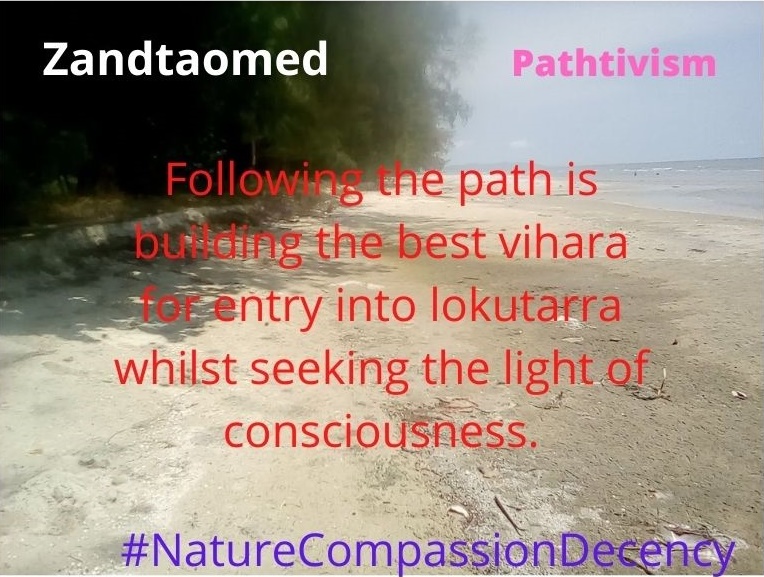
So we consider
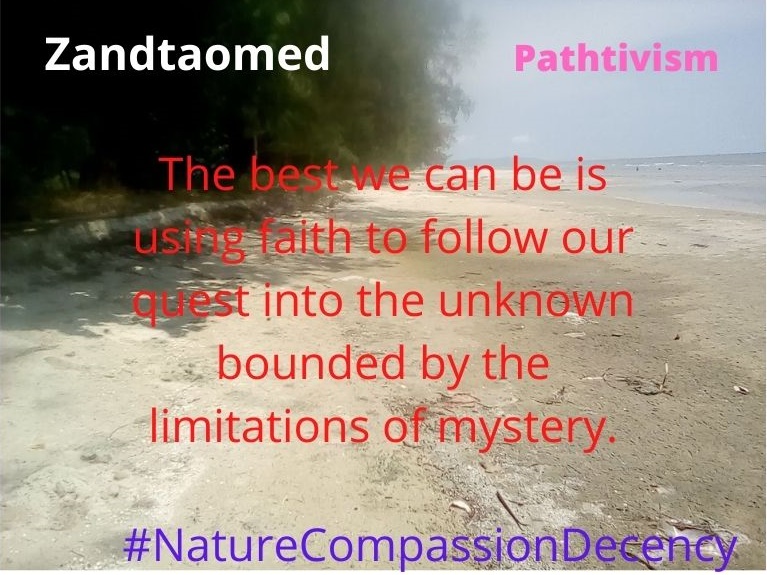
And what we do:-
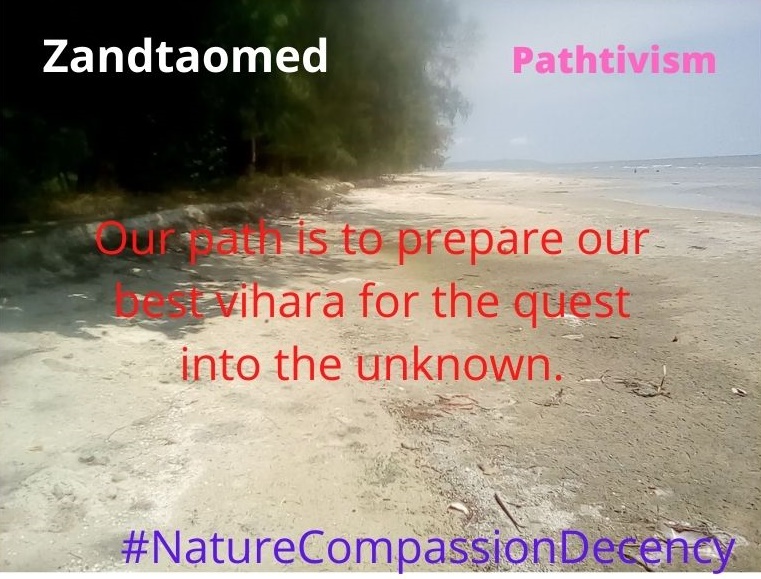
When considering the advice on Eckhart's Inner Light our path is both Eckhart and Buddhadasa. Eckhart's methodology focusses on consciousness, Buddhadasa's methodology focusses on the vihara; on our paths we balance the two to do the best we can to be the best we can be. This last balance was a bit of a revelation to me as I woke up to write just about vihara (which has been my emphasis for following the path so far). Whilst Viveka-Zandtao has led me into quest and faith I am not as yet sure of the implications of the methodology of Eckhart’s consciousness – to be the best we can be.
So far following the path is:-

This has two parts:-

and
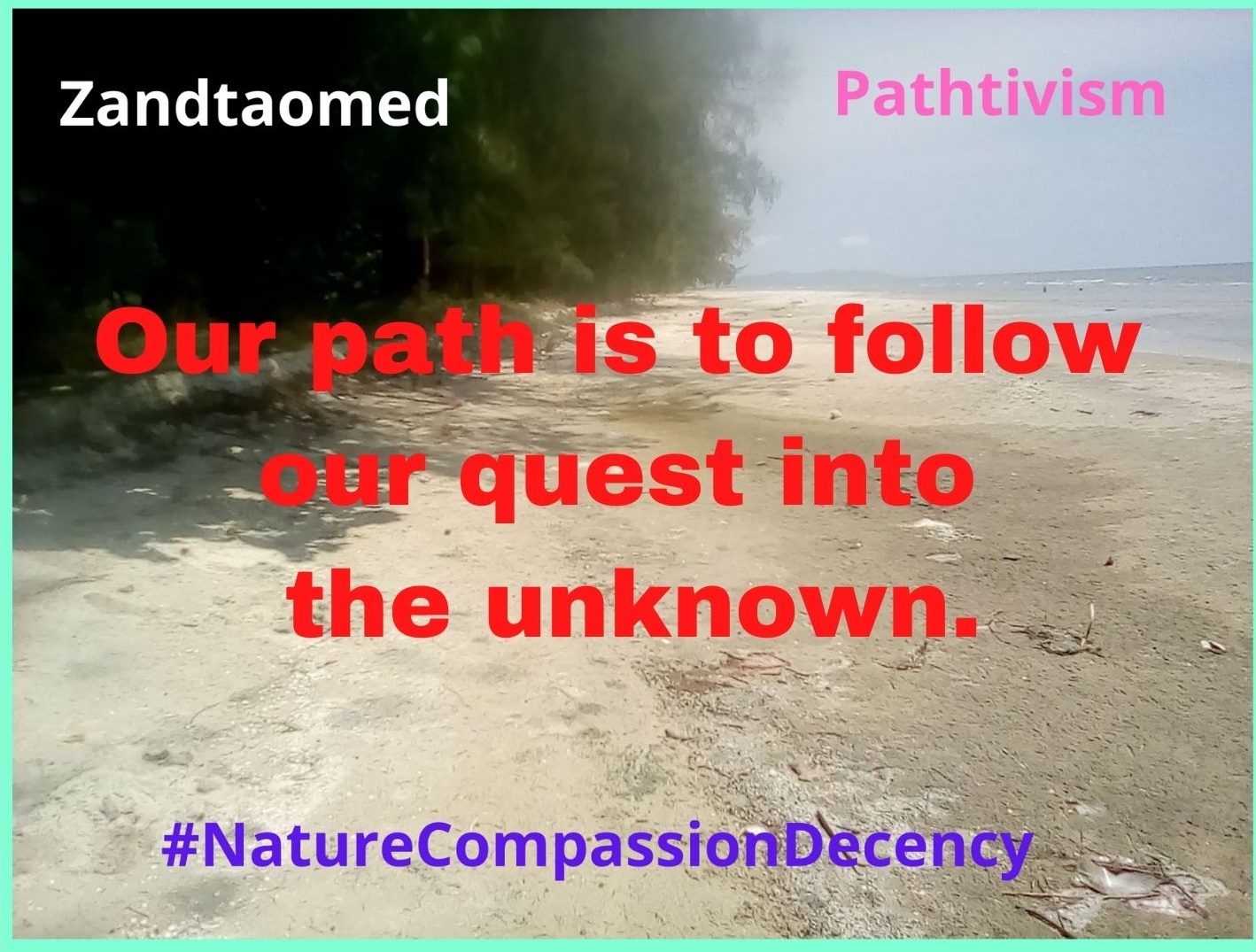
For me this is MwB.
To be the best we can be:-
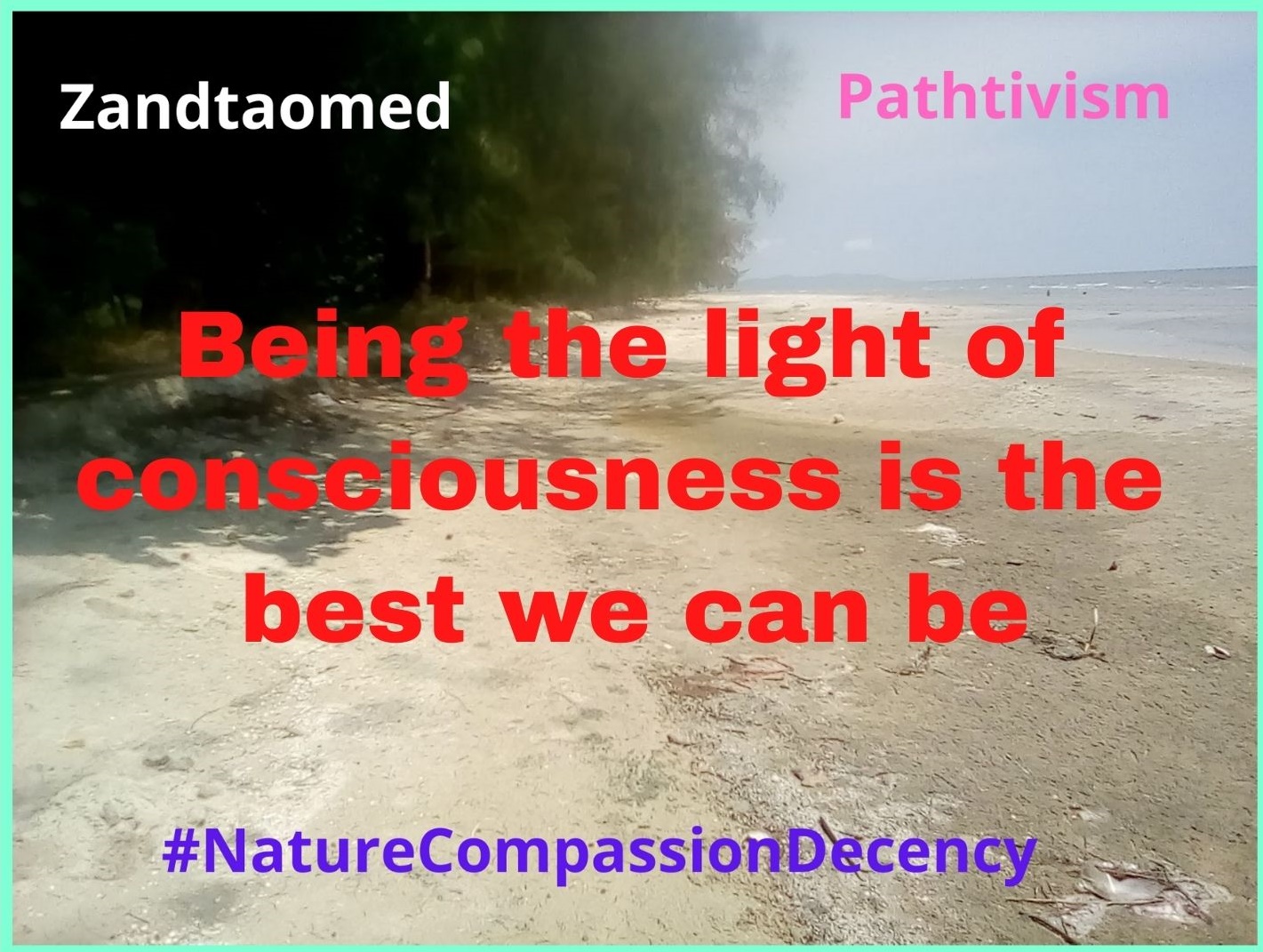
This is an extra step I have just started in my meditation, I build the abode with MwB and then try to join deep into the light of consciousness.
The path gives us faith to follow the path, and go deep into the light of consciousness. Furthermore faith accepts the mystery, it accepts the unknown and that we can work with the unknown. We can accept consciousness, we can accept being part of universal consciousness without knowing what that universal consciousness is. I follow the path, I have faith in the path, I have faith in and accept consciousness.
I ended the section on faith by saying I will examine the final chapter on faith in Sharon’s book - “What can any of us place our faith in that endures? According to Buddhist teachings, to discover that is to know the deepest level of faith” [SS p168]. An excellent question, what endures? Eckhart’s answer would be universal consciousness, so combining Sharon and Eckhart faith would be placed in consciousness – that endures.
So what is this deepest level of faith that Sharon talks of? Surely it is concerning the mystery of consciousness. Following the path is concerned with two approaches. In the first approach we look at doing the best we can by preparing the best vihara to enter the realm of lokutarra. In the section of faith, I discussed faith in this context when resolving the “faith revelation”. In this section I used the term “vihara” to describe the preparation of the first 3 tetrads of kaya, vedana and citta before hopefully entering lokutarra in the 4th tetrad. Equivalent to entering lokutarra is the two-step process of vihara and faith to join with the light of consciousness – to use faith to connect with the unknown Dhamma.
The second approach of the path is quest – the quest to follow the path. This quest for the unknown could also be described as a quest for consciousness, but how can we use our minds that remain in understanding to seek what is unknown? This is then faith, the faculty often described as heart that connects with the unknown mystery of consciousness. To enter deep into the light of consciousness we need faith in the teachings that take us to mystery – to consciousness. Through the known teachings we develop the vihara, and by dwelling in vihara we can maybe transcend and receive the fruits of firstgrace and phala to show us the way of the path. We can then have faith to go deep. Can there be a more valuable human faculty than the faculty that connects us to the unknown mystery of consciousness – is this the deepest level of faith?
“Then, as we come to deeply know the underlying truths of who we are and what our lives are about, abiding faith, or unwavering faith as it is traditionally called, arises” [SS p169]. I will use unwavering faith as the term abiding faith could be confused because vihara is sometimes thought of as an abiding. Do we live in faith or do we use our unwavering faith to join deep into the unknown mystery of consciousness? When we think of living in faith there is a feeling of holding a set of beliefs, faith in consciousness is not concerned with beliefs. Vihara is not concerned with beliefs either, it is concerned with keeping the body healthy, releasing blocked feelings, emotions and energy, developing the brahma-viharas of compassion, loving-kindness, empathy and equanimity, as well as letting go of kilesas and ending upadana – holding to a belief is upadana.
What can we take with us when we die? This is a mystery, and therefore faith must be involved. On death vihara dies, but is there something to be answered? In our quest for consciousness is there meaning for this question of what we take with us, such a meaning as conscious participant in the creativity of universal consciousness – discussed as part of Awakening the Inner light here?
This is a mystery, mystery 2 of Eckhart’s universal consciousness. Eckhart’s universal consciousness and Buddhadasa’s sunnata are in agreement except for terminology. But in Awakening the Inner Light Eckhart takes the mystery further. He says universal consciousness is evolving, and humans need to consciously participate in this. So in a sense what we take with us when we die is that we have helped evolve consciousness because the vihara dies with us. Quest for consciousness is effectively our legacy even though after death we cannot be aware of this. It is natural – just the way it is. This is Eckhart’s description of the mystery, do I have faith in it?
When I make a limited investigation of Buddhist literature there is no discussion of evolving sunnata, there is just sunnata. Evolving implies time, is time a characteristic of sunnata? I think not, so at present I am tending not to have faith in this mystery – maybe that will change. When using your faith be intense but don’t waste it - use it sparingly.
The longer I have become conscious of faith the more I see its discerning use as important in following the path. Let me begin with a downside – obsession. I got ripped off by a big business, post office and dishonest logistics. Basically delivery drivers told the tracking system the pre-paid parcel had been delivered when it hadn’t, and the payment was released; no-one would back me up. I became obsessed with this – losing sleep. Sure this was pointless and wasteful, but why did I become so obsessed and suffer? I watched suffering happen whilst I had this obsession; I just watched myself get sucked in – it was too powerful. Until I realised that the obsession was a downside of faith.
It felt like sunnata poured in, and I felt great at this realisation. So obsession was a downside of the new faith. What about addiction? Misguided love? And the previously stated cults? They all fit into the faith vacuum:-

Having faith in the path ends all these downsides. Be 100% dedicated to the path, use your magnetic faith and follow the path.
So what about vihara? The path means develop the viharas, karuna, metta, mudita and upekkha; complete the vihara. What detracts from the viharas? Attachment and clinging – kilesa and upadana. What is attachment and clinging? Misplaced consciousness that faith has attached and clung to, instead of faith following the path, faith is misguided becoming clinging and attachment. If there is no attachment and clinging then there is 100% dedication to the path, so that we can have complete faith in the path. Complete the vihara so we can have complete faith in following the path. This clearly brings me to consider what Sharon means by the unwavering faith I associated with path.
Before I do that, I want to talk about completion. Building the complete vihara creates connection to the Dhamma, if the vihara is complete there is connection. Is there a need for faith? And in a sense the answer is no if there is 100% completion, 100% completion and dedication, vihara, faith completion and following the path are all one and the same thing. However faith comes in to complement and help the completion or integration process. What we do is a dual process. We work on building the complete vihara, and we work on increasing our faith so that we can join the light of consciousness. In completion there is no sense of separation, in completion we join the light of consciousness because we are complete. We work on building the vihara, and whilst that building is happening we use our faith to join with the light of consciousness – faith makes up for the lack of completion. Following the path therefore has two components:-
 Building the complete vihara to join the light of consciousness. Building the complete vihara to join the light of consciousness.
 Dedicating to our faith in the path so that we can join with the light of consciousness. Dedicating to our faith in the path so that we can join with the light of consciousness.
On completion I would assume faith becomes obsolete as in completion (theoretically speaking because I don’t know) there is complete connection to the Dhamma. Until then (you wish  ) I build the vihara and dedicate to my faith, a faith where I try to remove clinging, a faith that is free from ditthupadana and silabattupadana – the usual detractions that reduce the power of faith. ) I build the vihara and dedicate to my faith, a faith where I try to remove clinging, a faith that is free from ditthupadana and silabattupadana – the usual detractions that reduce the power of faith.
So I am returning to consideration of the final chapter of Sharon Salzberg’s book “What can any of us place our faith in
that endures? According to Buddhist teachings, to discover
that is to know the deepest level of faith” [SSp168]. My immediate reaction to this is nothing – anicca nothing endures. She is talking of the faith that endures in life – the faith to follow the path, to find buddha-nature. “[A]s we come to deeply know the underlying truths of who we are and what our lives are about, abiding faith, or unwavering faith as it is traditionally called, arises” [SSp169].
“Abiding faith does not depend on borrowed concepts. Rather, it is the magnetic force of a bone-deep, lived understanding, one that draws us to realize our ideals, walk our talk, and act in accord with what we know to be true” [SSp169]. This starts well, it is not views or a borrowed dogma - ditthupadana. But I very much like “magnetic force”, a force whose magnetism attracts to the light of consciousness, attracts our true path, a path that has known understanding and faith to take us into the unknown.
She quotes Paul Tillich “Theologian Paul Tillich defines this kind of faith as alignment with our “ultimate concern, those values to which we are most devoted, which form the core of what we care passionately about. An ultimate concern is not an interest that is merely a fashion or a whim, but one that is a centering point for our lives” [SSp169]. Ultimate concern and mystery of consciousness can easily be seen as the same, the path as centring point of our lives, these of course are not fashion or whim – conditioning, but nor are they values. But if some were to see the 4 Dhamma comrades as values it is a different use of the term value rather than a disagreement. Sharon continues to use ultimate concern [SS pp169-170], and in that continued usage I equate it with following the path; Suzuki Roshi’s compassion I have no problem with but she gave Bernice Reagan’s justice as an example of ultimate concern – justice is non-attached, could civil rights justice be too attached to daily life rather than consciousness?
“For those who aspire to the freedom from suffering taught by the Buddha, the primary repository of abiding faith is our own buddha nature. Because Buddhist teachings arise out of the experience of a human being, rather than being conferred by a deity, great emphasis is placed on abiding faith in oneself, in one’s true capacities” [SSp172]. Faith in buddha-nature, a magnetic force attracted to buddha-nature – our true capacities, our authenticity – path.
“Whatever we might be conditioned to believe, the teachings say that beneath our small, constricted, Lucy-defined identity lies the innate capacity for awareness and love that is buddha nature. This is what faith in ourselves rests upon” [SSp172]. Faith in our buddha-nature, faith in our path.
I wish to conclude Viveka-Zandtao by bringing together salient points of this chapter. Beginning the chapter, I usefully went around in circles trying to find the path. By examining different ways of describing the path – connecting to Dhamma, touching sunnata, autonomy amongst others, it became clear there was no answer to “what is the path?”; but that does not mean it is not possible to follow the path.
Here is a way of how to follow the path:-

Following the path is not obeying teachings, it is finding the essence of teachings – this is your path. It is important to know whether we have been following the path, and nature gives us the rewards of phala so that we can know what we are doing is right. The phala are rewards, they are not the path – don’t become attached to phala; the phala are signposts so we know what we are doing – learn to identify phala and try to know when they arise. “The path of pathtivism is not the teachings but something that is developed beyond the teachings" – the Essence of the teachings. "Through our practice we begin to recognise phala, and through that recognition have faith and conviction in our actions and understanding"
I put forward a method for following the path, and this method focusses on Ajaan Buddhadasa’s method of meditation – Anapanasati Bhavana – Mindfulness with Breathing - MwB; in Companion I discussed matters that arose concerning MwB and as my method recommend the two in conjunction. In following MwB we look at developing the 3 tenets of Zandtao (described in the Treatise):-

And from there we integrate these 3 tenets to build the vihara that enables us to transcend (reach lokutarra) and touch sunnata.
In the process of building the vihara we also build our faith by letting go of attachments and clingings (misplaced magnetic force). Through our conditioning we become attached to kilesa and to the 4 upadana of desire, views, rituals and self; by following MwB we let them go. As they are let go the magnetic forces of attachment and clinging is released and can be returned to faith.
Having faith in the path means that we join with the light of consciousness, touch sunnata, connect to the Dhamma, and develop the autonomy of our own true paths. As to the path itself it is a mystery, it is meant to be a mystery. Nature does not tell us what the path is, but it does give us the tools to follow the path. We build our viharas, release the magnetic forces of attachment and clinging that can enable our faith so that we can follow our quest into the unknown - following the path. And nature gives us phala to know what we are doing. We have determination to build the vihara – doing the best we can – to join with the light of consciousness – to be the best we can be.


Theory/Practice/Quest/Faith/Path/
|



 Zandtao Meditation page
Zandtao Meditation page
 Advice from Zandtaomed
Advice from Zandtaomed